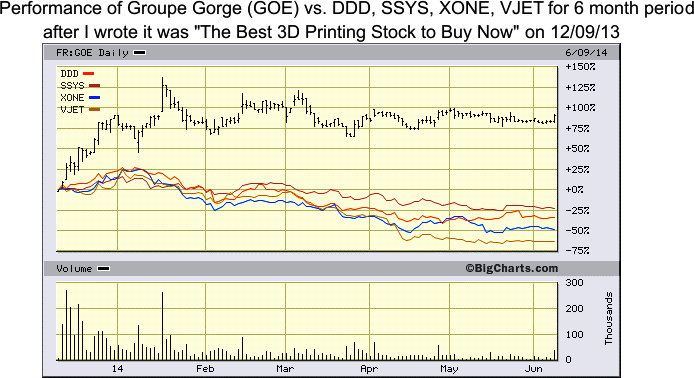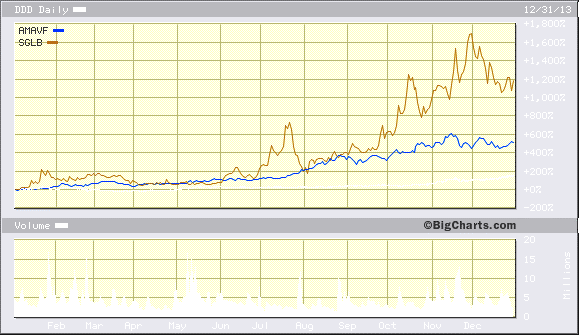The 3 Best Stocks For 2014
Post on: 16 Март, 2015 No Comment

In order to consider which stocks will be the best in 2014 there is quite a bit of leg work to do. First of all, the macroeconomic factors need to be sorted. What will the U.S. economy be like? What type of shape will the world economy be in? Which sectors will benefit from those economic situations? That is only part of what needs to be taken into consideration.
For the rest of 2013 there are several major headwinds that both the U.S. and global economies need to overcome. The sequester is one of those headwinds. The U.S. government has been inept for the better part of the last decade. Going from the housing bubble, to the financial crisis, to the debt ceiling debacle. In order to attempt to portray to the public some semblance of fiscal responsibility, the two political parties agreed to $1 trillion in spending cuts over ten years to programs both sides value dearly. Sure enough, those spending cuts will cost workers thousands of jobs when the defense, education, and other public services have their budgets cut. By 2014, those budget cuts should be in full effect. With those budget cuts, we want to avoid those sectors.
In 2014 we also have the new healthcare program, or Obamacare, taking full effect. I have personally spoken with many different individuals in the insurance arena, as well as many different financial advisors who offer insurance products. None of them know exactly how the new healthcare program will work or effect the healthcare industry or the insurance industry. Uncertainty is not a friend to the market. If you don’t believe that, check back to the financial crisis, European debt crisis, housing bubble, or debt ceiling debate. That being said, it would be wise to avoid the healthcare and insurance provider sectors until the new healthcare program sorts itself out.
Next, we have the subject everyone has an opinion on, quantitative easing. The Federal Reserve has been pumping billions of dollars back in to the economy. The end of quantitative easing is coming, that goes without saying. All of the debate on everyone’s lips is when that end is coming. If employment numbers continue to improve, probably over the next six months, it would be advisable to expect the Fed to end quantitative easing. With an end to quantitative easing, the markets will need to stand on their own two feet. The end of quantitative easing will most likely spark a short term pullback in the market as the market has been depending on the Fed’s assistance for several years. That pullback will be the buying opportunity I am looking for.
After the end of quantitative easing the Fed should look to signal the end of historically low interest rates. An interest rate increase will encourage banks to diversify away from proprietary trading activities and increase lending. With increased lending, businesses will be able to expand their businesses. With business expansion comes more hiring and lower unemployment. Lower unemployment means more disposable income for consumers to use on bigger ticket items such as vehicles, luxury items, homes, and items of the like. An interest rate increase should be expected late in 2014. The logic behind that being that the Federal Reserve will want to give the markets and economy time to digest the end of quantitative easing, and allow them both time to stand on their own. With the end of quantitative easing most likely to come in Q4 of 2013, six months of improved jobs numbers puts us in September or October, a year without quantitative easing will give the Federal Reserve enough time to reevaluate the markets.
The other major headwind to take in to consideration is the eurozone. Continuing uncertainty in the eurozone will continue to put pressure on the markets. Unfortunately, there is no way to predict the viability, stability, or sustainability of the eurozone in its current form. There are simply too many political factors and issues that still need to be resolved. What is foreseeable is that the eurozone will continue to be a macroeconomic factor working against the markets over the next year or two at a minimum. For the most part, we want to avoid sectors that could be adversely effected by a eurozone collapse.
With all of that in mind, we can look into 2014 for the three best stocks.
Facebook — (NASDAQ:FB ) has only reported two quarters worth of mobile ads, and the revenue from those mobile ads increased by 100% in a single quarter. Even with a modest projection of 25% growth in the mobile ad space each quarter, that would result in Facebook generating over $1 billion in mobile ad revenue in a single quarter by the end of 2014. That would equal 20% of Facebook’s total current revenue. While the number of new users may be slowing, mobile users are still increasing. Mobile ads are where Facebook’s obvious growth is.
However, Facebook is beginning to monetize the business more aggressively. The Gifts program launched by Facebook shows serious potential with over 100 companies participating in the launch of the program back late last year. Facebook has also rolled out a Gift Card program that allows consumers to obtain a single gift card that is usable at hundreds of outlets. Future fundamental valuation measures have Facebook slightly overvalued at the moment (Forward P/E of 33.10, a P/S of 11.80, and a PEG ratio of 1.60), but Wall St. could very well be underestimating revenue growth of the new products Facebook has rolled out. The new Timeline Facebook unveiled will allow FB to show more ads, and allow for the introduction of video ads as well.
One of the best factors for Facebook is that it sidesteps any eurozone factors and the end of quantitative easing. Meanwhile, Facebook will enjoy the benefits of an improving U.S. economy as retailers advertise more to capture the increase of disposable income consumers enjoy from lower unemployment. Look at Q1 earnings closely to confirm a move higher for the social media giant, mobile ad revenue equal to Q4 will signify significant growth coming out of the holiday retailer ad season. Price target by the end of 2014: $46.00.
NXP Semiconductor — (NASDAQ:NXPI ) is poised for a breakout over the next couple of years. NXP provides leading technology that is becoming the new it item in technology. NXPI has some of the best patents in the NFC technology space. NFC technology allows individuals to use their mobile devices to do everything from paying for their bill at a bar, to checking out a library book, to doubling as a state ID. NXP Semiconductor’s list of clients include Apple (NASDAQ:AAPL ), Microsoft (NASDAQ:MSFT ), Google (NASDAQ:GOOG ), and Samsung just to name a few. That is quite an impressive client list, all of which are leaders in the mobile technology space.
Future valuations have NXP Semiconductor being grossly undervalued. NXPI trades with a Forward P/E of 8.47, a P/S of 1.71, and a PEG ratio of 0.38. Experts in the technology space are expecting Apple to unveil NFC technology in the new iPhone, which would mean that the two companies with the largest market share would be offering NFC technology. Retailers are also preparing for the move towards NFC friendly commerce. Wal-Mart (NYSE:WMT ), Target (NYSE:T ), 7-Eleven, Best Buy (NYSE:BBY ), Sears (NASDAQ:SHLD ), and other retailers have teamed together to form a company to provide NFC capabilities to their customers in store. With major retailers making such an aggressive move, it is hard to imagine that NFC technology won’t be a major driver for commerce in the future. Again, NXP Semiconductor is able to avoid the pitfalls of the adverse macroeconomic factors while being able to enjoy the benefits. If Apple does come out with NFC technology active in the new phone, I would expect NFC technology and NXP Semiconductor with it to soar. Price target by the end of 2014: $50.00.

Ford — (NYSE:F ) has possibly the best fundamentals out of any auto manufacturer out there. Ford trades with a Forward P/E of 7.83, a P/S of 0.39, and a PEG ratio of 0.91. Combine that with a healthy and pretty secure 3% dividend. Ford has extremely strong fundamentals. Total assets have grown by more than 15% over the past three years, while liabilities have grown by less than 8%. Ford also was just announced the manufacturer with the greatest customer loyalty. The combination of strong fundamentals, customer loyalty, a vehicle boasting the second best MPG in the non plug-in hybrid space in the Fusion all show promise for Ford.
The negative economic factors should leave Ford relatively unscathed. While Ford is exposed to the eurozone, they depend on domestic sales to a much higher degree. Increased employment numbers will help drive sales higher, and the public image of Ford is much stronger than rival General Motors (NYSE:GM ) after they defaulted on government loans. Toyota (NYSE:TM ) still has the best selling hybrid in the Prius, but Ford still has the buy American angle over them. Watch the Ford Fusion sales numbers closely for growth potential. If the Ford Fusion can climb up the ranks from the tenth most popular hybrid vehicle per sales, expect Ford’s stock reap the rewards. Price target by the end of 2014: $20.00.
JP Morgan (NYSE:JPM ) is the best company, with the best CEO, in a recovering banking sector. If the Eurozone can resolve their issues, JPM will lead the banking sector.
Caterpillar (NYSE:CAT ) will suffer from the effects of the sequester, but politicians need to create jobs for public support. The easiest way for politicians to do that is to repair roads, bridges, and railways. Caterpillar will benefit greatly from it.
Twitter will be interesting to watch when it goes public either in late 2013 or early 2014 most likely. Twitter will be the most hyped IPO since Facebook. The valuation will be key for the success of the IPO, but Facebook’s debacle could help keep that valuation in line.
Disclosure: I am long FB. NXPI. CAT. AAPL. I wrote this article myself, and it expresses my own opinions. I am not receiving compensation for it (other than from Seeking Alpha). I have no business relationship with any company whose stock is mentioned in this article. Always consult with your own registered financial professional before adding a new position to your portfolio. Investing involves a significant risk of loss, as such never invest more than you can afford to lose.














